
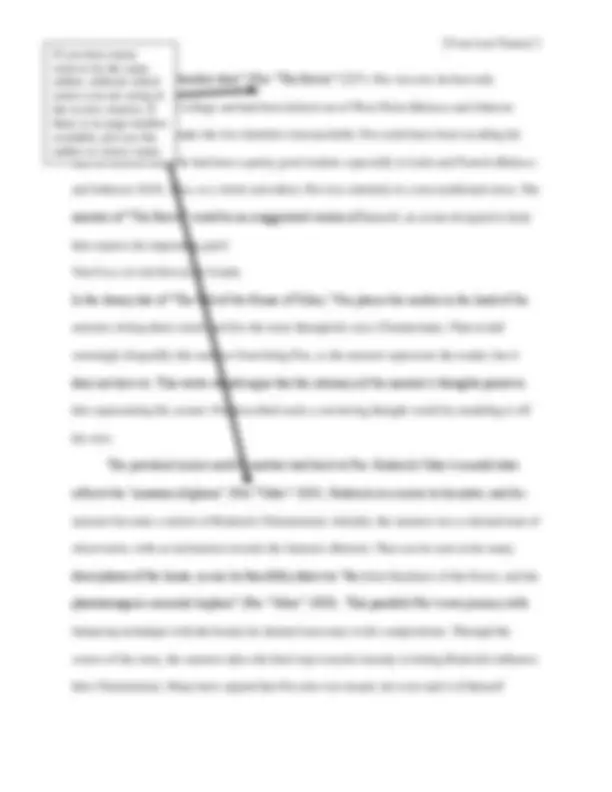
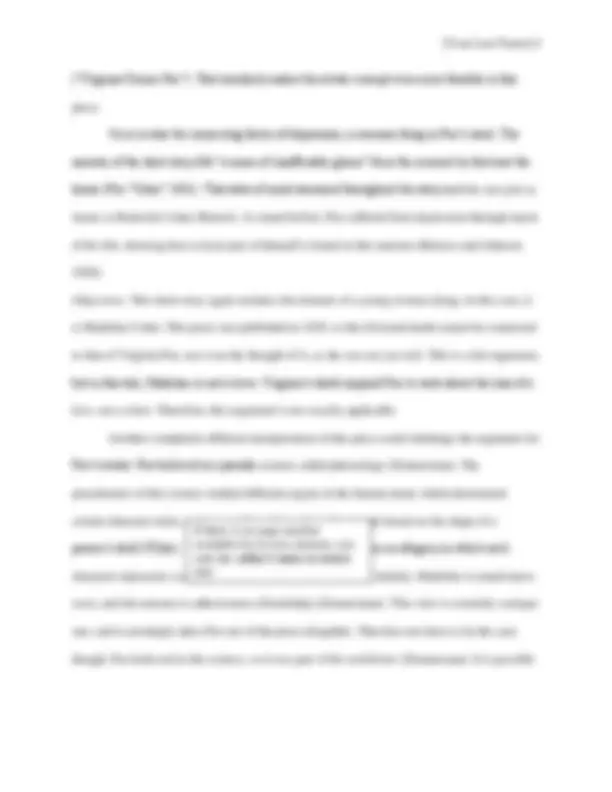
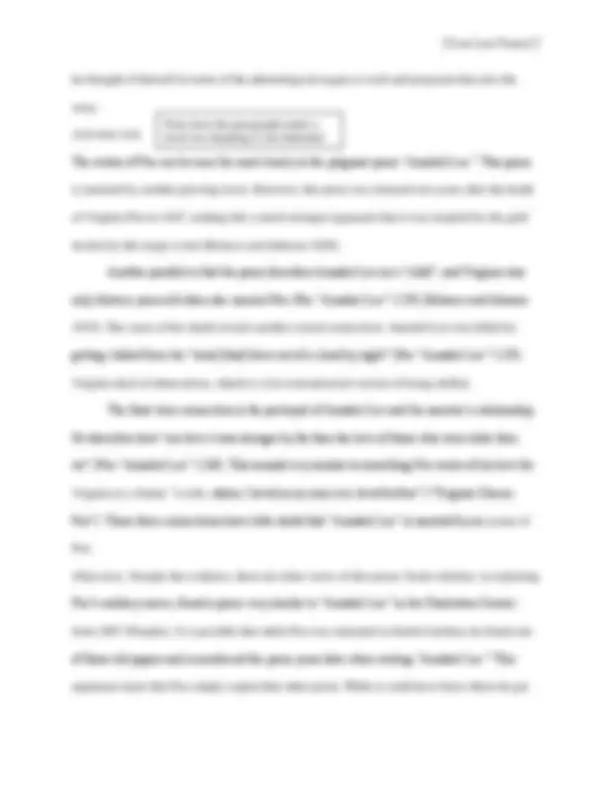
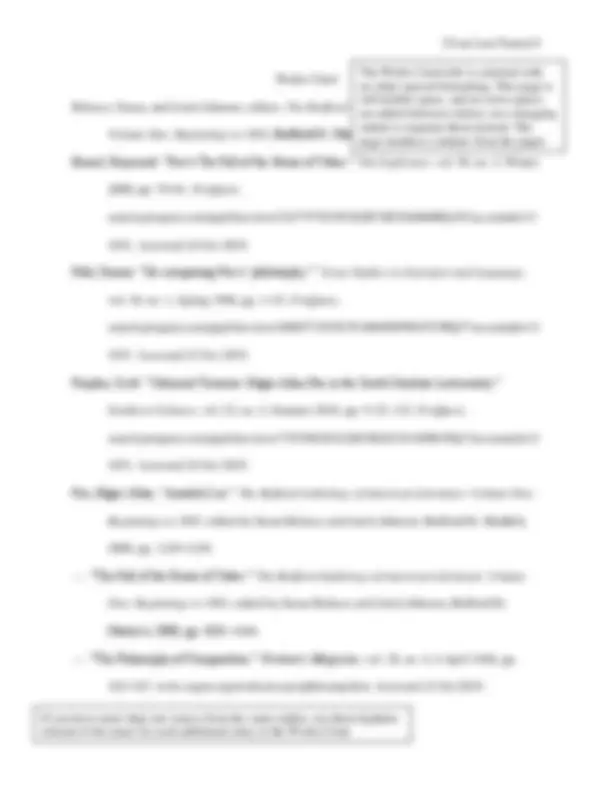
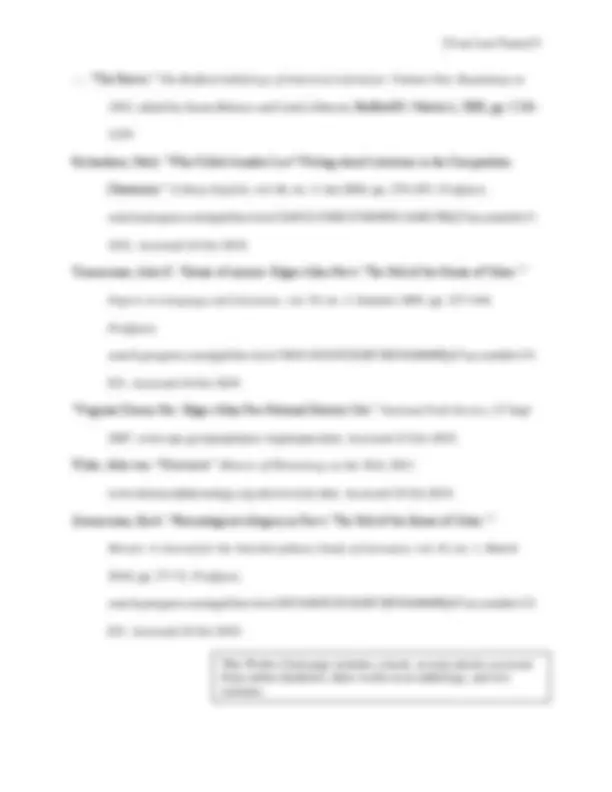


Study with the several resources on Docsity

Earn points by helping other students or get them with a premium plan


Prepare for your exams
Study with the several resources on Docsity

Earn points to download
Earn points by helping other students or get them with a premium plan
Community
Ask the community for help and clear up your study doubts
Discover the best universities in your country according to Docsity users
Free resources
Download our free guides on studying techniques, anxiety management strategies, and thesis advice from Docsity tutors
How Edgar Allan Poe used himself as a model in his stories, specifically in 'The Raven', 'The Fall of the House of Usher', and 'Annabel Lee'. The essay delves into the connections between Poe's life and these works, discussing his depression, lost love, and use of mirror motifs. It also addresses objections to this interpretation.
What you will learn
Typology: Study notes
1 / 9

This page cannot be seen from the preview
Don't miss anything!






Example Student Professor Thomas Crank EN223: American Literature 1 26 October 2019 Poe’s Avatars Edgar Allan Poe is renowned for his gothic short stories and poetry. His tales of the dark and macabre engrossed the morbidly curious readers of his time and continue to do so today. Many of his stories have the recurring themes of loss and sorrow, and several of those plots reveal those themes with the same device: the death of a beautiful, young woman. Poe himself said that this was “the most poetical topic in the world” (Poe “Philosophy” 165). It is ironic, then, that this most poetical of topics would occur in his own life with the death of his wife. That blurring of the lines between literature and reality is a common occurrence for Poe, as several of his narrators could be viewed as versions of himself projected onto the page. Many scholars have explored this interpretation among several other thematic meanings. This paper observes and addresses those different views while defending the thought of Poe using himself as a model in his stories. Three of his works in particular, “The Raven,” “The Fall of the House of Usher,” and “Annabel Lee,” seem to best reveal this concept of literary avatars. THE RAVEN The most obvious connection to Poe’s life in “The Raven” is that the narrator of the poem lost his love, “the rare and radiant maiden whom the angels name Lenore,” like Poe lost his wife (Poe “The Raven” 1226). However, upon examining the timeline, that connection weakens. “The Raven” earned its creator much praise and success in 1845, two full years before Virginia Poe would die (Belasco and Johnson 1020). This does not mean that the poem is completely
The whole paper is double spaced, 12-point Times New Roman font. The heading is your name, professor, class, and the date formatted day month year. Page numbers include your last name. The title is centered with no other special formatting. The essay will follow right after.
This level two heading is in S on Word’s home ribbon through the carrot in the corner ofMALL CAPS, which is found the font section. This is only necessary with essays over ten pages.
disqualified as a bearer of Poe’s image. Virginia Poe died after a five-year battle with tuberculosis (“Virginia Clemm Poe”). That means that her husband watched her suffer continuously through the progression of the disease and probably thought she would die more than once. In fact, that is exactly what Poe wrote to a friend. He said that at every relapse, he “felt all the agonies of her death” (“Virginia Clemm Poe”). It is not unreasonable to think that Poe imagined what it would be like if Virginia died when he wrote his most well-known poem. The narrator of “The Raven” ends his tale by lamenting that “my soul…shall be lifted nevermore!” (Poe “The Raven” 1229). This sounds strongly of a depressive state, which Poe was known to experience (Belasco and Johnson 1020). This narrator could well be a projection of Poe dealing with the possible death of his wife, anticipating it worsening his preexisting depression. He writes that the narrator has no hope of seeing his love ever again, so if it is an avatar, the poem reveals his fear of eternal separation from Virginia. Objections. There are several arguments against the narrator in “The Raven” being a version of Poe. For one thing, he has explained where his inspiration for the poem came from in his essay “The Philosophy of Composition.” Nowhere in that piece does he mention that his ailing wife adding to his inspiration. He claims to have chosen every single detail out of necessity to reach the intended effect. This would seem to remove any possibility of the poem representing Poe. There is, however, a belief that this particular essay was less about the actual method of composing the poem than about capitalizing on and enhancing its popularity (Pahl). That is not to say that Poe is a liar, but that the essay may not be completely truthful (Pahl). If this view is accurate, the case for Poe using himself as a model is still a valid possibility. Another argument against this view is the fact that the narrator of “The Raven” is a scholar, a young man (Poe “Philosophy” 166). This is evident by the presence of a “bust of
In a source with no author, use the title of the source.
This level three heading is in italics, and the paragraph begins immediately after it. Headings are really only needed for essays over ten pages.
If a source has two authors, name them both.
(“Virginia Clemm Poe”). That similarity makes the avatar concept even more feasible in this piece. There is also the connecting factor of depression, a common thing in Poe’s work. The narrator of the short story felt “a sense of insufferable gloom” from the moment he first saw the house (Poe “Usher” 1031). That state of mind worsened throughout the story until he was just as manic as Roderick Usher (Benoit). As stated before, Poe suffered from depression through much of his life, showing how at least part of himself is found in this narrator (Belasco and Johnson 1020). Objections. This short story again includes the element of a young woman dying. In this case, it is Madeline Usher. This piece was published in 1839, so this fictional death cannot be connected to that of Virginia Poe, nor even the thought of it, as she was not yet sick. This is a fair argument, but in this tale, Madeline is not a lover. Virginia’s death inspired Poe to write about the loss of a love, not a sister. Therefore, this argument is not exactly applicable. Another completely different interpretation of this piece could challenge the argument for Poe’s avatar. Poe believed in a pseudo-science called phrenology (Zimmerman). The practitioners of this science studied different organs in the human mind, which determined certain character traits, and one could predict and see those traits based on the shape of a person’s skull (Wyhe). “The Fall of the House of Usher” may be an allegory in which each character represents a certain phrenological organ: Roderick is ideality, Madeline is amativeness (sex), and the narrator is adhesiveness (friendship) (Zimmerman). This view is certainly a unique one, and it seemingly takes Poe out of the piece altogether. That does not have to be the case though. Poe believed in this science, so it was part of his worldview (Zimmerman). It is possible
If there is no page number available for in-text citations, use only the author’s name or source title.
he thought of himself in terms of the phrenological organs as well and projected that into the story. ANNABEL LEE The avatar of Poe can be seen the most clearly in the poignant poem “Annabel Lee.” This poem is narrated by another grieving lover. However, this piece was released two years after the death of Virginia Poe in 1847, making this a much stronger argument that it was inspired by the grief incited by this tragic event (Belasco and Johnson 1020). Another parallel is that the poem describes Annabel Lee as a “child”, and Virginia was only thirteen years old when she married Poe (Poe “Annabel Lee” 1229) (Belasco and Johnson 1019). The cause of her death reveals another crucial connection. Annabel Lee was killed by getting chilled from the “wind [that] blew out of a cloud by night” (Poe “Annabel Lee” 1229). Virginia died of tuberculosis, which is a less romanticized version of being chilled. The final clear connection is the portrayal of Annabel Lee and the narrator’s relationship. He describes how “our love it was stronger by far than the love of those who were older than we” (Poe “Annabel Lee” 1230). This sounds very similar to something Poe wrote of his love for Virginia to a friend: “a wife, whom I loved as no man ever loved before” (“Virginia Clemm Poe”). These three connections leave little doubt that “Annabel Lee” is narrated by an avatar of Poe. Objections. Despite the evidence, there are other views of this poem. Some scholars, in exploring Poe’s military career, found a poem very similar to “Annabel Lee” in the Charleston Courier from 1807 (Peeples). It is possible that while Poe was stationed in South Carolina, he found one of those old papers and remembered the poem years later when writing “Annabel Lee.” This argument states that Poe simply copied that other poem. While it could have been where he got
Note how the paragraph under a level two heading is not indented.
If the highborn kinsman killed Annabel Lee, there is more of a struggle to reconcile the literary and real worlds, but it is not impossible. Annabel Lee was born away by her kinsman in the poem. Either that means she was forcibly taken from a disapproved relationship and died of a broken heart on top of disease, or else they locked her in an unhelpful hospital (Richardson). Virginia and Poe were never separated this extremely, so this interpretation seems to remove the possibility of an avatar. Nevertheless, if the kinsmen are symbolic, it may not. Society deemed their marriage odd because they were cousins, and she was thirteen when they got married (Belasco and Johnson 1019). If the kinsmen represent society, it shows the disapproval implied in the poem. The second view of failed treatment, if accurate, may show Poe’s frustration with ineffectual hospitals and medical care that allowed Virginia to die anyway. CONCLUSION There are many arguments for and against Edgar Allan Poe’s use of avatars in his stories and poetry. In every work of writing, part of the author is present in the story, whether that simply be the voice or completely embodied in a character. Each work is part of the writer, and Poe is no different. Even if none of these stories were intended to represent him, part of him is in all three, but the constant presence of depression and the inclusion of a dead woman mirror Poe’s life a little too eerily and closely. “The Raven,” “The Fall of the House of Usher,” and “Annabel Lee” reveal Poe’s mind and feelings through their narrators acting as avatars of Poe in literary worlds.
Works Cited Belasco, Susan, and Linck Johnson, editors. The Bedford Anthology of American Literature: Volume One: Beginnings to 1865 , Bedford/St. Martin’s, 2008. Benoit, Raymond. “Poe’s The Fall of the House of Usher.” The Explicator , vol. 58, no. 2, Winter 2000, pp. 79–81. ProQuest , search.proquest.com/pqrl/docview/216775745/3F202B72B5564080PQ/10?accountid=
If you have more than one source from the same author, use three hyphensinstead of the name for each additional entry in the Works Cited.
The Works Cited title is centered with no other special formatting. This page isstill double-space, and no extra spaces are added between entries; use a hanging indent to separate them instead. The page numbers continue from the paper.